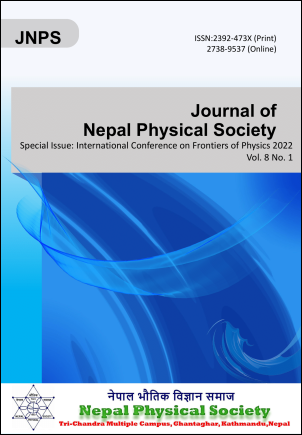Influence of ambient relative humidity on horizontal visibility in the two cities of western Nepal having contrasting urban-cum-industrial backgrounds and study of long-term variation
DOI:
https://doi.org/10.3126/jnphyssoc.v8i1.48287Keywords:
air pollution, meteorology, relative humidity, trend, visibilityAbstract
Atmospheric visibility, a measure of horizontal distance one can distinctly see with unaided eye, is affected by the scattering and absorption of visible light by the tiny particles (aerosols), or different gases present in the atmosphere. Thus, visibility is commonly considered a proxy for ambient air quality. The long-term trend of visibility may reflect the change in the air quality of a place over the period. In our study, we have analyzed historic climatological data (1977-2020) from the National Oceanic and Atmospheric Administration (NOAA) global hourly archive, for the two cities of west Nepal, namely, Bhairahawa (BWA, 27.506 °N, 83.416 °E) and Surkhet (SKH, 28.6 °N, and 81.617 °E). We have found that both of the synoptic stations exhibited persistent degraded visibility. BWA had poorer visibility conditions (poor air quality) than that of SKH since the beginning of the study period. Since 2014, the ‘annual good day’ (V ≥ 10 km ) at BWA is steadily near 0%, and the ‘annual bad day’ (V < 5 km) is ≈ 60%, suggesting a degraded air quality. Similarly, we observed a notable decline in the 50th percentile of visibility in the mid-1980s at SKH, and a sharp decline of ‘good day’ since 2011. Meteorology modifies the optical properties of aerosol/ gaseous in the atmosphere, thereby, resulting in a change in visibility. In our study, we have investigated the influence of relative humidity (RH) on prevailing visibility. Although the relationship between them exists in both of the stations, it is more distinctly visible at BWA. We observed lower visibility conditions (V ≤ 3 km) occurring at an RH level as low as 50% at BWA. This indicates an abundance of specific hygroscopic aerosols, whose light extinction thresholds are as low. At BWA, the impact of RH is evident during the dry season. In contrast, the threshold value of RH is quite high (80%) at SKH and the relationship is prominent during the wet season. This alarmingly poor air quality at both stations requires a serious concern because of its adverse impact on various sectors like aviation, tourism, and public health.
Downloads
Downloads
Published
How to Cite
Issue
Section
License
All right reserved. No part of this Journal may be reproduced in any form or by any electronic or mechanical means, including information storage and retrieval system, without permission in writing from the publisher, except by a reviewer who may quote brief passage in a review. The views and interpretation in this journal are those of author(s) and they are not attributable to the NPS.




